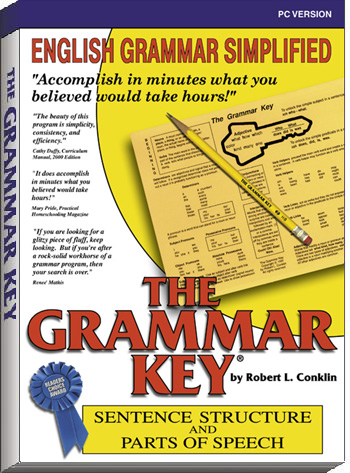The GrammarKey Sentence Structure & Parts of Speech CD | The GrammarKey Puncutation & Mechanics CD
The GrammarKey Workbook | The GrammarKey Card Pack | GrammarKey Diagram | View Video | Reviews Research | FAQs | Pricing for Institutions | Pricing for Individuals
|
|
|
|
The Grammar Key is Easy-to-Use, Proven Software for Mastering the Elements of English Grammar on 2 CD-ROMS:
The Grammar Key Sentence Structure & Parts of Speech
The Grammar Key Punctuation and Mechanics
|
|
|
|

The beauty of this program is simplicity, consistency, and efficiency.
Cathy Duffy
Curriculum Manual
The Grammar Key is both a traditional and unique approach to grammar that helps students understand the rules of grammar and transfer those rules to their own writing.
The Grammar Key is designed for young students having difficulty with grammar and writing, for adults who are not necessarily English majors or adults in ABE or GED programs, and for ESL teachers who want alternatives to teaching English grammar to foreign students.
The Grammar Key builds on students’ previous knowledge of English and motivates them by demonstrating how much they already know.
What sets The Grammar Key apart from other grammar programs? Since the emphasis is placed on the total sentence, students understand writing as a body of related skills working together.
How does The Grammar Key work? Since words combined into sentences follow predictable patterns, the aim of The Grammar Key is to first make students aware of these patterns and then help them absorb the rules that describe these patterns; turning grammar into a seamless mechanism they can apply to their own writing.
|
Why Teach Grammar on a Computer? Since grammar is systematic, it can be taught on a computer, and since a computer never gets tired, it can repeat key words and grammatical patterns to the degree that they become internalized in the student’s mind. A computer can. |
|
What’s the difference between The Grammar Key Sentence Structure & Parts of Speech and The Grammar Key Punctuation & Mechanics? It might be helpful to examine the punctuation error in this sample sentence: "When students know the structure of a sentence and the parts of speech they have no problem grasping the rules of punctuation." You must also know the punctuation rule that states a comma always follows an introductory clause before the main clause begins. THIS IS WHAT WE TEACH IN THE GRAMMAR KEY PUNCTUATION & MECHANICS CD-ROM. Then the answer is simple: "When students know the structure of a sentence and the parts of speech, they have no problem grasping the rules of punctuation." |
